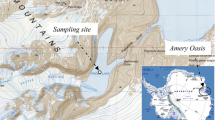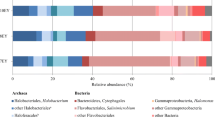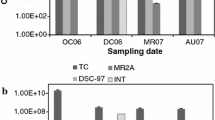Abstract
The Nanoarchaeota, proposed as the fourth sub-division of the Archaea in 2002, are known from a single isolate, Nanoarchaeum equitans, which exists in a symbiotic association with the hyperthermophilic Crenarchaeote, Ignicoccus. N. equitans fails to amplify with standard archaeal 16S PCR primers and can only be amplified using specifically designed primers. We have designed a new set of universal archaeal primers that amplify the 16S rRNA gene of all four archaeal sub-divisions, and present two new sets of Nanoarchaeota-specific primers based on all known nanoarchaeal 16S rRNA gene sequences. These primers can be used to detect N. equitans and have generated nanoarchaeal amplicons from community DNA extracted from Chinese, New Zealand, Chilean and Tibetan hydrothermal sites. Sequence analysis indicates that these environments harbour novel nanoarchaeal phylotypes, which, however, do not cluster into clear phylogeographical clades. Mesophilic hypersaline environments from Inner Mongolia and South Africa were analysed using the nanoarchaeal-specific primers and found to contain a number of nanoarchaeal phylotypes. These results suggest that nanoarchaeotes are not strictly hyperthermophilic organisms, are not restricted to hyperthermophilic hosts and may be found in a large range of environmental conditions.



Similar content being viewed by others
References
Baker GC, Cowan DA (2004) 16S rDNA primers and the unbiased assessment of thermophile diversity. Biochem Soc Trans 32:218–221
Baker GC, Smith JJ, Cowan DA (2003) Review and re-analysis of domain-specific 16S primers. J Microbiol Methods 55:541–555
Barns SM, Delwiche CF, Palmer JD, Pace NR (1996) Perspectives on archaeal diversity, thermophily and monophyly from environmental rRNA sequences. Proc Natl Acad Sci USA 93:9188–9193
Brochier C, Forterre P, Gribaldo S (2005) An emerging phylogenetic core of Archaea: phylogenies of transcription and translation machineries converge following addition of new genome sequences. BMC Evol Biol 5:36
Brochier-Armanet C, Boussau B, Gribaldo S, Forterre P (2008) Mesophilic Crenarchaeota: proposal for a third archaeal phylum, the Thaumarchaeaota. Nat Rev Microbiol 6:245–252
Ciccarelli FD, Doerks T, von Mering C, Creevey CJ, Snel B, Bork P (2006) Toward automatic reconstruction of a highly resolved tree of life. Science 311:1283–1287
Galtier N, Gouy M, Gautier C (1996) Seaview and phylo_win: two graphical tools for sequence alignment and molecular phylogeny. Comput Appl Biosci 12:543
Hohn MJ, Hedlund BP, Huber H (2002) Detection of 16S rDNA sequences representing the novel phylum “Nanoarchaeota”: Indication for a wide distribution in high temperature biotopes. Syst Appl Microbiol 25:551–554
Huber H, Hohn MJ, Rachel R, Fuchs T, Wimmer VC, Stetter KO (2002) A new phylum of Archaea represented by a nano-sized hyperthermophilic symbiont. Nature 417:63–67
Jahn U, Gallenberger M, Paper W, Junglas B, Eisenreich W, Stteter KO, Rachel R, Huber H (2008) Nanoarchaeum equitans and Ignicoccus hospitalis: new insights into a unique intimate association of two Archaea. J Bact 190:1743–1750
Kumar S, Tamura K, Nei M (2004) MEGA3: integrated software for molecular evolutionary genetics analysis and sequence alignment. Brief Bioinform 5:150–163
McCliment EA, Voglesonger KM, O’Day PA, Dunn EE, Holloway JR, Cary SC (2006) Colonization of nascent, deep-sea hydrothermal vents by a novel Archaeal and Nanoarchaeal assemblage. Environ Microbiol 8:114–125
Paper W, Jahn U, Hohn MJ, Kronner M, Näther DJ, Burghardt T, Rachel R, Stetter KO, Huber H (2007) Ignicoccus hospitalis sp. nov., the host of “Nanoarchaeum equitans”. Int J Syst Evol Microbiol 57:803–808
Stach JEM, Bathe S, Clapp JP, Burns RG (2001) PCR-SSCP comparison of 16S rDNA sequence diversity in soil obtained using different isolation and purification methods. FEMS Microbiol Ecol 36:139–151
Thompson JD, Gibson TJ, Plewniak F, Jeanmougin F, Higgins DG (1997) The clustalx windows interface: flexible strategies for multiple sequence alignment aided by quality analysis tools. Nucleic Acids Res 25:4876–4882
Waters E, Hohn MJ, Ahel I, Graham DF, Adams MD, Barnstead M et al (2003) The genome of Nanoarchaeum equitans: insights into early archaeal evolution and derived parasitism. Proc Natl Acad Sci USA 100:12984–12988
Acknowledgments
Chinese, Tibet and Inner Mongolian sediment samples were obtained under the auspices of the joint Chinese-EU-SA MGATech project (QLRT-2001-01972). Chilean sediment samples were obtained by Dr. J. Blamey. GCB was supported by the Royal Society/NRF Program. NG and AC were supported by the NRF HBU-RDP Program. DNA sequencing was conducted by Di James at the University of Cape Town Sequencing Facility and Inqaba Biotech, South Africa. We would like to thank H. Huber for supplying “N. equitans” genomic DNA.
Author information
Authors and Affiliations
Corresponding author
Additional information
Communicated by T. Matsunaga.
Nucleotide sequence data reported are available in the GenBank database under the accession numbers AY727886-AY727891, AY571283, AY572420, EF562614-EF562627 and EU493244-EU493252.
Rights and permissions
About this article
Cite this article
Casanueva, A., Galada, N., Baker, G.C. et al. Nanoarchaeal 16S rRNA gene sequences are widely dispersed in hyperthermophilic and mesophilic halophilic environments. Extremophiles 12, 651–656 (2008). https://doi.org/10.1007/s00792-008-0170-x
Received:
Accepted:
Published:
Issue Date:
DOI: https://doi.org/10.1007/s00792-008-0170-x




